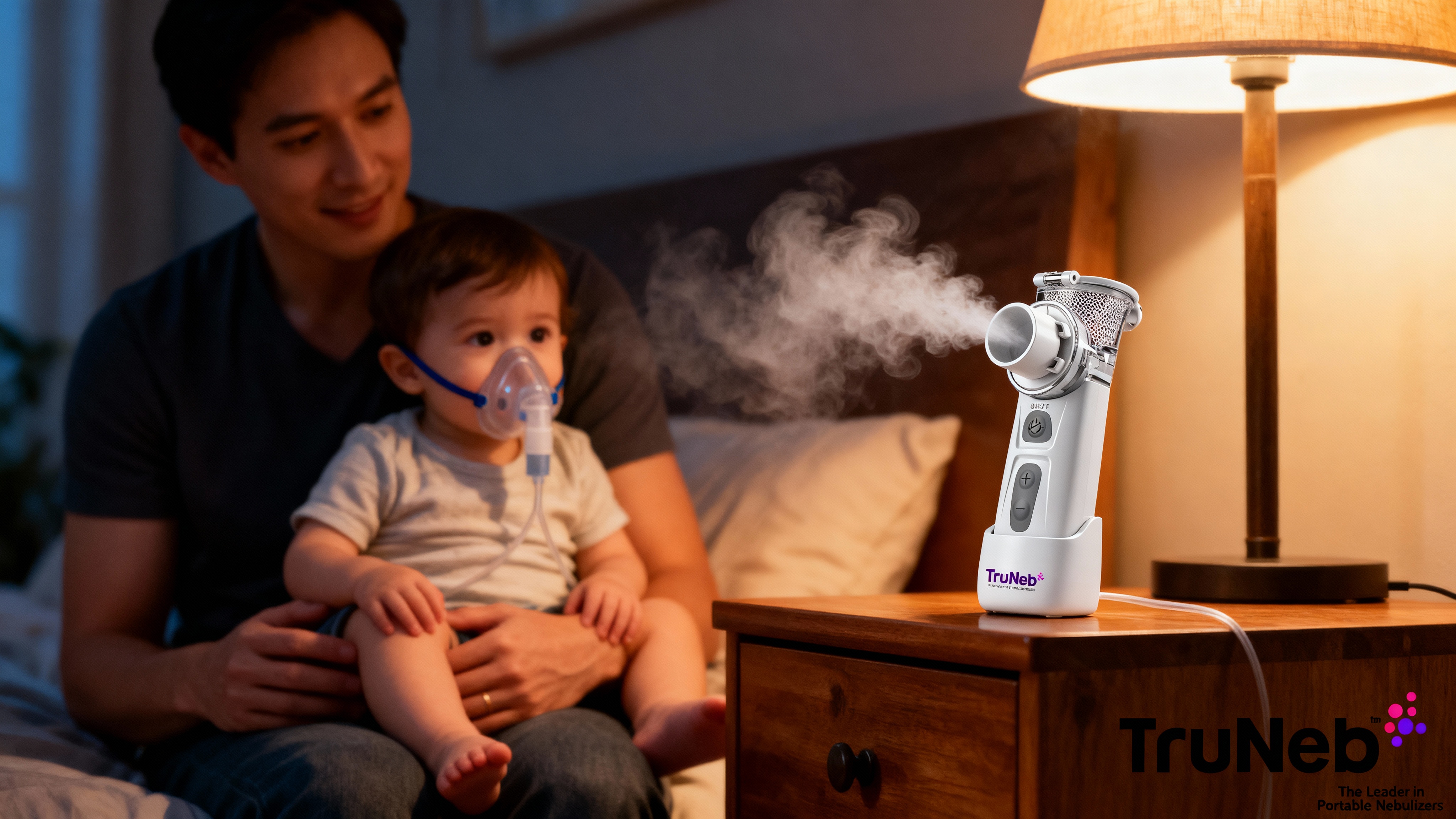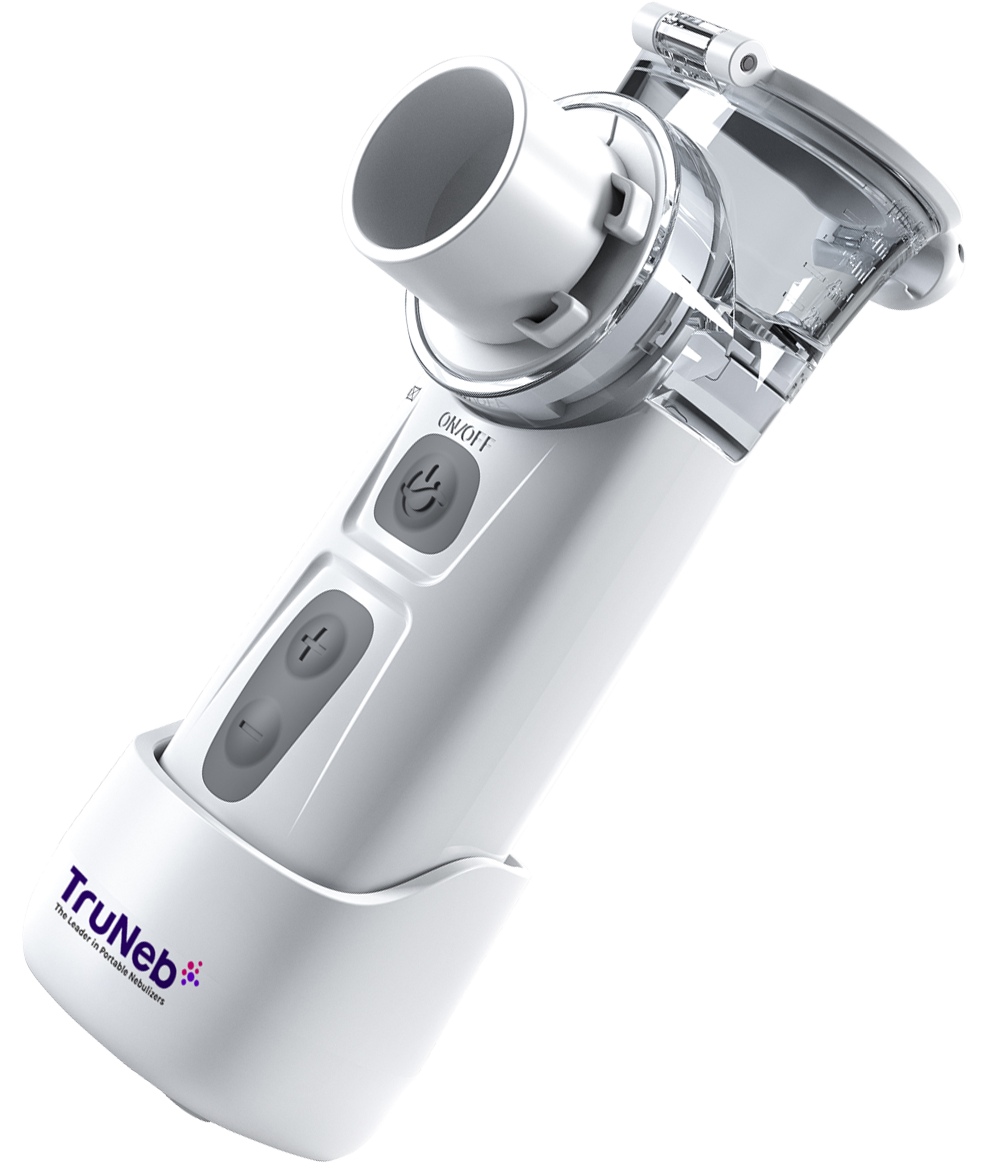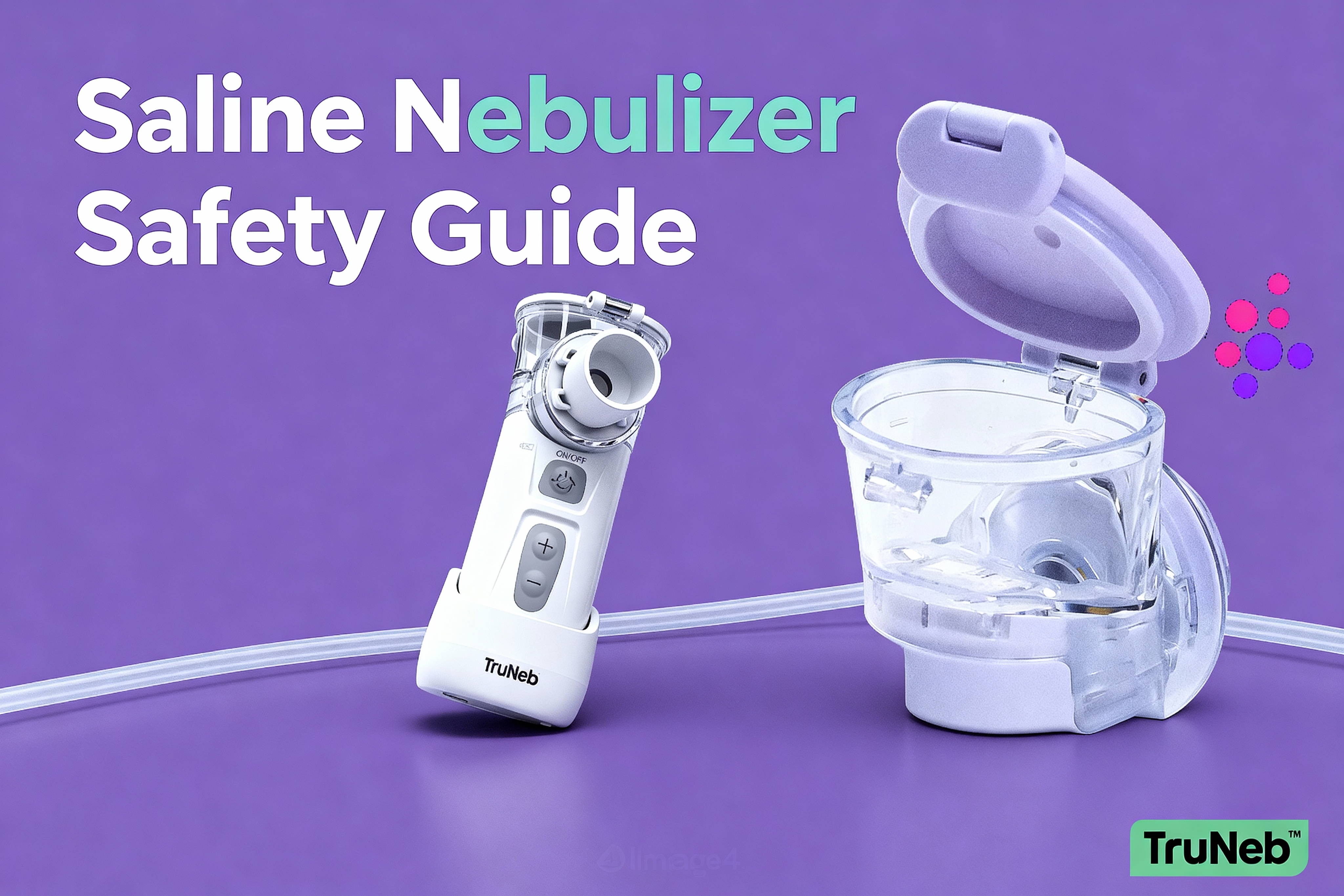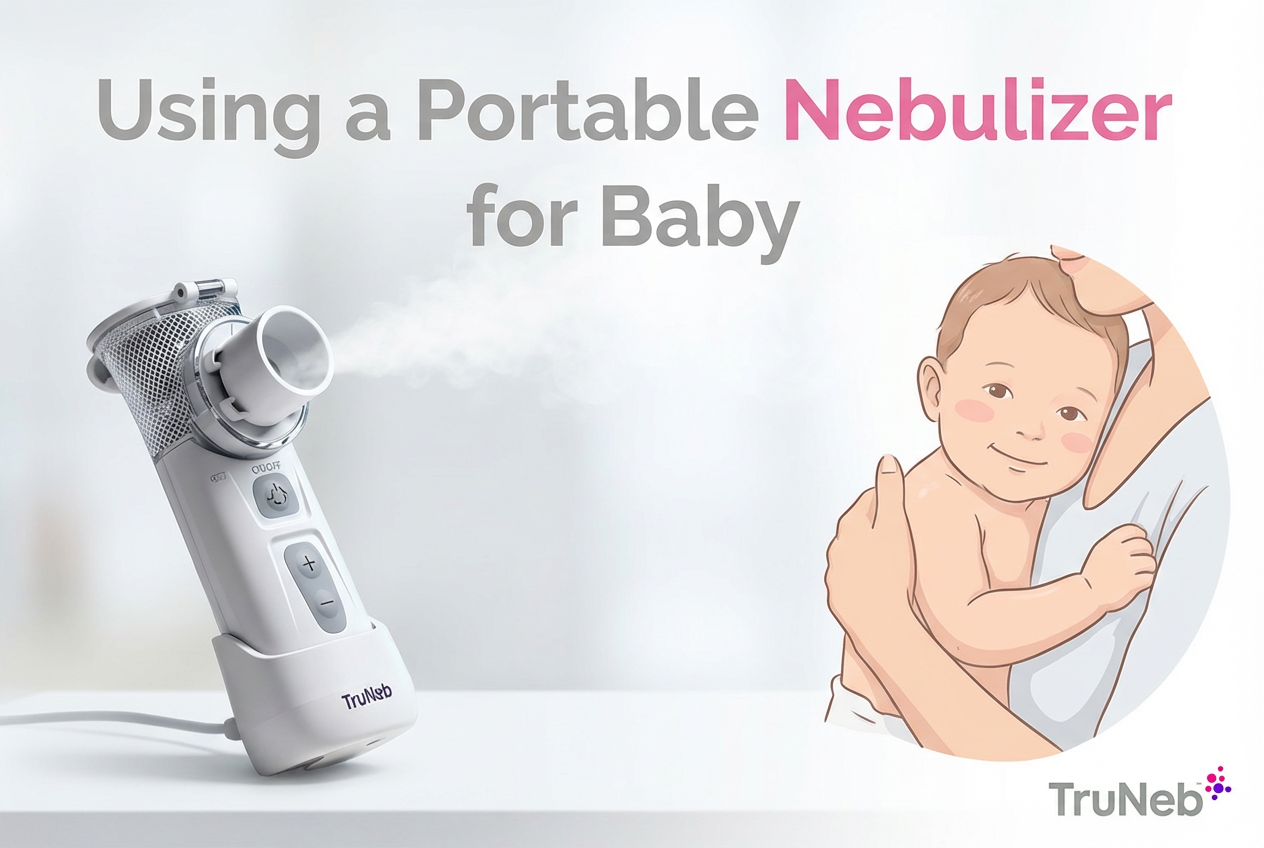On this page

What Is a Pediatric Nebulizer and Why Do Kids Need It?
A pediatric nebulizer is a small device that turns liquid medicine into a gentle mist so your child can breathe it in through a mask or mouthpiece. The word “pediatric” mostly refers to kid-sized accessories and quieter, easier designs. The way it delivers medicine is the same as a regular nebulizer.
Why it helps kids: many infants and toddlers can’t time a deep breath with an inhaler, even with a spacer. A nebulizer lets them breathe normally for a few minutes while the mist does the work. Doctors commonly use nebulizers for asthma symptoms, wheezing with bad colds, and in some cases for extra-thick mucus.
Rule of thumb: a nebulizer can make treatments easier for children under school age because it doesn’t require breath coordination.
A pediatric nebulizer turns liquid medicine into a fine mist so babies and kids can simply breathe it in.
When Is a Nebulizer Used for a Child? Common Conditions and Scenarios
- Asthma: Nebulized bronchodilators (like albuterol) are often prescribed for young kids during flare-ups because they can simply breathe the mist in.
- Bronchiolitis/RSV in infants: Some doctors use nebulized saline (3% or 7%) to help loosen mucus. Your doctor will guide if and when to do this at home.
- Croup and sudden noisy breathing: In urgent settings, a nebulizer is sometimes used to quickly deliver certain medicines.
- Chronic lung conditions: Some children with ongoing lung disease rely on daily nebulized medicines as part of their care plan.
Simple cue: if your child can’t use an inhaler correctly or needs steady mist for a few minutes, a nebulizer is commonly recommended.

Key Features to Look For in a Pediatric Nebulizer
- Quiet operation: Loud machines can scare little ones. Handheld mesh models (and some ultrasonic designs) are typically very quiet, which helps at bedtime or during naps.
- Portable power: Rechargeable, cordless units make it easy to treat in the car, on trips, or bedside without searching for an outlet.
- Proper pediatric masks: Look for soft, child-sized masks (often infant and child sizes). A good seal helps the mist reach the lungs.
- Fast treatments: Devices that finish a typical dose in about 5–10 minutes can make sessions easier for wiggly kids.
- Easy to use and clean: Fewer parts and one-button start help when you’re holding a child and managing supplies.
- Kid-friendly design: Gentle shapes or simple, non-intimidating looks can reduce fear and resistance.
Example: a portable mesh nebulizer like TruNeb™ is quiet, cordless, and sized for travel, which can make treatment time smoother for your child.
Bottom line: when shopping for the best pediatric nebulizer, choose a quiet, portable unit with child-sized masks and quick, simple sessions.
Quick comparison: home compressor vs portable mesh
| Feature | Why it matters | Home compressor | Portable mesh |
|---|---|---|---|
| Noise | Quieter sound helps toddlers stay calm | Moderate hum | Very quiet |
| Power | Use treatments anywhere (car, bedside) | Wall outlet only | Rechargeable, cordless |
| Masks | Proper fit improves delivery | Often adult kit by default | Pediatric sizes commonly included |
| Treatment time | Shorter sessions help wiggly kids | ~10–15 minutes | ~5–10 minutes |
| Size/weight | Easier to pack and hold | Tabletop unit | Handheld, travel-ready |
| Cleaning | Simpler parts save time | More parts; tubing/filter upkeep | Fewer parts; rinse and air-dry |
Note: Treatment time varies by device and medication volume.
Mask Sizing and Getting a Snug, Comfy Fit
- Pick the right size: Use the infant mask for babies and the child mask for toddlers/preschoolers so it gently covers nose and mouth.
- Check the seal: Hold the mask softly against the face. Avoid big gaps where mist can escape.
- Soothe first: Calm breathing helps more mist reach the lungs. A short pause to settle crying can improve the treatment.
- Make it routine: Read a short story, sing, or play a favorite show to make “nebulizer time” feel safe and predictable.
Some pediatric kits include a pacifier-style adapter that lets infants suck while inhaling the mist—helpful if they won’t tolerate a mask.
Quick tip: if your unit includes different mask sizes, try both and choose the one that seals best without pressing too hard.
Travel and Nighttime Use: Real-Life Tips
- Keep a portable, fully charged nebulizer in your diaper bag or car kit so you’re ready away from home.
- At night, a quiet cordless device lets you treat bedside without bright lights or moving rooms.
- Pack extra masks and pre-measured medicine vials for trips so sessions are quick and simple.
- Pack the nebulizer and medications in your carry-on; medical devices are allowed on planes.
Rule of thumb: if you can use it one-handed in a dim room, it’s likely a good fit for late-night care.
Cleaning and Maintenance: Keep It Safe for Little Lungs
- After each use: Rinse the mask and medicine cup with warm water. Shake off excess and air-dry on a clean towel.
- Daily (with frequent use): Wash parts with mild dish soap and warm water. Rinse well and air-dry completely.
- Weekly (or as directed): Disinfect only parts the maker approves. Many parents use a 1:3 white-vinegar-to-water soak for 30 minutes, then rinse and air-dry. Check your manual to avoid damaging mesh components.
- Never use essential oils or thick liquids in a nebulizer.
- Care notes: Do not submerge electronic parts. Replace worn masks or parts as needed. Keep batteries charged and store the kit dry.
One-liner: clean, dry parts help prevent germs and keep treatments working as expected.
Safety Notes and When to Seek Care
- Use only medicines or saline your child’s doctor recommends.
- Watch your child during treatments and stop if they seem worse.
- Keep the device and parts clean to reduce germ risk.
- ⚠️ Seek emergency care (call 911) if your child has severe trouble breathing, blue or gray lips or face, ribs or neck pulling in with each breath, is unusually drowsy, or you can’t get them to drink or respond.
- ⚠️ Call your doctor if symptoms don’t improve after treatments, your child needs treatments more often than prescribed, or you’re thinking about changing any medication.
- Do not put essential oils or thick solutions in a nebulizer.
- Steam inhalers are not nebulizers and are not used for breathing prescription medications.
Talk to your doctor before trying a new medication or changing any prescribed treatment.
If your child has severe breathing trouble or signs of low oxygen, seek emergency care right away.
Frequently Asked Questions
Tap or click a question below to see the answer:
For very young kids, a nebulizer can be easier because they just breathe normally. Older kids usually do well with an inhaler and spacer. Follow your pediatrician’s plan.
Yes, when used correctly under medical guidance. Hold your baby upright, use the infant mask, and watch them closely.
Most sessions take about 5–10 minutes, depending on the device and dose.
Pediatric versions usually include kid-sized masks and simpler, quieter designs. The mist delivery works the same.
No. Steam inhalers heat water to produce steam and are not used to deliver prescription breathing medications. Nebulizers aerosolize liquid medicine into a fine mist for inhalation.
TruNeb Portable Mesh Nebulizer for Kids
The TruNeb Portable Mesh Nebulizer is quiet, cordless, and easy to pack. It includes masks sized for families and runs on a rechargeable battery, so you can treat at home, bedside, or on the go. Short, simple sessions help reduce stress for you and your child.
If your doctor recommends nebulized saline, TruNeb offers compatible hypertonic saline (3% or 7%) options for congestion support. Learn more about how TruNeb can make breathing treatments easier for your family.
TruNeb is a quiet, portable mesh nebulizer with pediatric masks, designed to make treatments easier at home or on the go.
Disclaimer: This article is for informational purposes only and isn’t a substitute for professional medical advice. Always talk with your doctor about your child’s symptoms and treatments.







